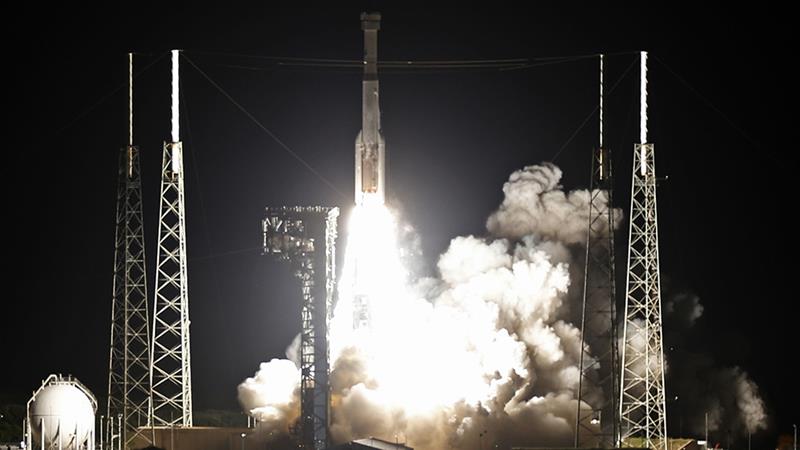Clock error caused spacecraft to go off planned trajectory, missing ISS rendezvous.
Years behind schedule and over budget, Boeing Co. launched its Starliner astronaut capsule on Friday morning, but in a blow to the aerospace giant and NASA, the uncrewed capsule failed to reach the orbit necessary to rendezvous successfully with the International Space Station (ISS).
NASA administrator Jim Bridenstine said that an onboard automated clock malfunctioned causing the Starliner to burn more fuel than anticipated. That extra burn put the spacecraft off-track and without an acceptable amount of fuel to make its rendezvous and dock with the ISS - the test flight's central objective.
"When the spacecraft separated from the launch vehicle we did not get the orbital insertion burn that we were hoping for," Bridenstine told reporters on Friday. "It appears as though the mission elapsed timing system had an error in it. And that anomaly resulted in the vehicle believing that the time was different than what it actually was."
Because it effectively had the incorrect time, the spacecraft mistakenly concluded that its orbital insertion burn had already occurred, and that it was not yet correctly positioned. So Starliner, in this automatic scenario, independently made corrections and burned fuel when it was not needed.
Normally, the Boeing flight control team would simply be able to take over and give the spacecraft the proper orders. But at the very time the flight team needed to speak with Starliner, it couldn't.
The radio signal between the ground and the spacecraft was being handed from one Tracking and Data Relay Satellite to another, and the connection was temporarily lost at the pivotal moment.
"By the time we were able to get signals up to actually command it to do the orbital insertion burn, it was a bit too late," said Bridenstine.
During the post-launch news conference, Bridenstine confirmed that Starliner was under control and in a stable orbit and that the cause of the error was being analysed. Approximately two hours into the mission, Boeing cut what was supposed to be a seven-day mission down to just over 48 hours.
Because the Starliner capsule will not meet up with the ISS, the plan according to both NASA and Boeing officials is to now bring it back to Earth for a 7:30am EST Sunday touchdown at White Sands Missile Range, in New Mexico.
Bridenstine said that because the safety systems performed correctly on this uncrewed test flight, he would not rule out placing astronauts on board for Boeing's next launch.
Nicole Mann, a US test pilot and astronaut who has been tapped to pilot a Starliner crew mission, told reporters, "we train extensively for this type of contingency. And had we been on board there could have been actions that we could have taken."
"We don't have any safety concerns," Mann added. "Everything on ascent, all the systems that would keep us safe have functioned properly on the launch and currently on the vehicle."
Once Boeing's flight control team took control of Starliner, it manoeuvred the capsule into what is called a "tail-sun" position, allowing the craft's solar arrays to capture sunlight and keep its batteries charged.
Launching at 6:36am EST (11:36 GMT), Boeing's Friday morning orbital flight test, or OFT, was a critical milestone in what has been a commercial human spaceflight programme beset by repeated delays and hundreds of millions of dollars in cost overruns.
Boeing is competing with SpaceX to develop commercial launch systems to restart NASA's human spaceflight capacity. SpaceX already launched an uncrewed Crew Dragon spacecraft to the ISS last March, moving Elon Musk's upstart company ahead of the aerospace behemoth.
In the half-hour after Starliner's launch, all launch systems performed seamlessly at supersonic speeds. The first stage rocket - the workhorse Atlas 5 - separated about four and a half minutes after liftoff. The second "upper" stage Centaur engines did the same roughly 10 minutes later, having placed the capsule into a suborbital trajectory.
At 31 minutes after launch, the Starliner capsule's four orbital manoeuvring and attitude control (OMAC) thrusters should have fired, but Boeing's mission controllers delayed that action. The initial reason for the delay was due to an incorrect attitude, or directional positioning, according to the Boeing communications team narrating the live broadcast event.
Steve Stich, NASA's Commercial Crew Program deputy manager, said, "The automation of the launch vehicle gets you into orbit, but then it was handing over to now the automation of the spacecraft. So that critical timeframe, clearly we missed something... so now we have to go figure out what happened and go solve the problem."
SOURCE: Al Jazeera News



